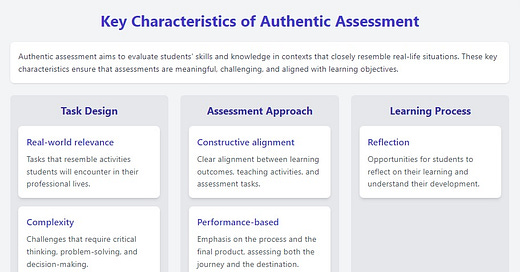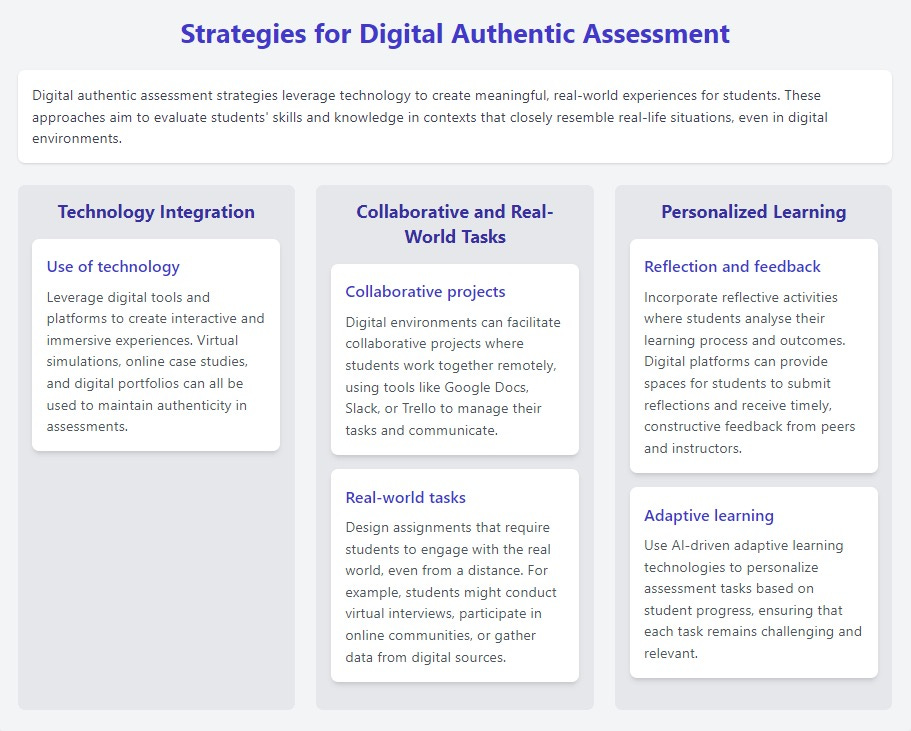Authentic Assessment and How It Applies to Digital Learning: Understanding Authentic Assessment
Kevin Ashford-Rowe, Queensland University of Technology
In the evolving landscape of education, the concept of authentic assessment has gained significant traction. Authentic assessment is a principle that informs assessment design with the aim of ensuring that assessments are fair, valid, reliable, and, most importantly, authentic. But what does ‘authentic’ mean in this context?
What Authentic Assessment Is
At its core, authentic assessment is about creating assessments that are relevant and applicable to the real world. In the work that I undertook with Jan Herrington and Christine Brown, Establishing the critical elements that determine authentic assessment, we determined that authentic assessment involves tasks that are complex, require higher-order thinking, and are reflective of real-life challenges and activities. This type of assessment is designed to evaluate not just what students know, but how they apply their knowledge in practical situations.
This means that no single assessment can be deemed entirely authentic or inauthentic; rather, assessments vary in their degree of authenticity. An authentic assessment closely mirrors the complexities and demands of real-world tasks, allowing students to demonstrate their knowledge and skills in a context that resembles their future professional environments. In fact, authenticity in assessment is relative and exists on a continuum from ‘more authentic’ to ‘less authentic’.
“More authentic <-----------------------------> Less authentic”
Authentic assessment is also not limited to a specific type of task or format (such as multiple-choice tests or essays). Instead, it is a principle that can be applied to various types of assessments to increase their relevance and alignment with real-world tasks. It can include a variety of methods such as projects, portfolios, presentations, simulations, interactive online orals, and case studies. The common thread is the emphasis on real-world application and the development of skills that are transferable beyond the classroom.
What Authentic Assessment Is Not
While authentic assessment offers many advantages, it is important to clarify what it is not.
Authentic assessment cannot meet all of the challenges related to assessment in education. For example, authentic assessment is not a simple panacea for meeting the challenges of generative artificial intelligence (AI). While it can make it more difficult for AI to complete tasks on behalf of students due to the complexity and specificity of the tasks, it does not eliminate the possibility.
Authentic assessment is also not a silver bullet for academic integrity. Authentic assessment can reduce opportunities for cheating by requiring personalised, context-specific responses, but it is not a foolproof solution. Academic dishonesty can still occur, and a multi-faceted approach to integrity, including clear policies, education, and technology, is necessary.
Finally, as mentioned above, authentic assessment is not limited to a specific type of assessment.
How do I know it’s authentic?
If authenticity in assessment is relative and exists on a continuum, the question then arises as to whether it is possible to understand and apply specific aspects of an authentic design in order to assist the educational and assessment designer to understand the level of authenticity that exists in a specific assessment mechanism.
Jan Herrington, Christine Brown and I suggested that, by identifying and codifying the individual elements of authenticity, it was possible to determine the ways in which the authenticity of an individual assessment activity might be enhanced.
Using the Authentic Assessment Rating Tool
We devised a set of eight critical questions that might be used to determine an ‘authenticity rating’ (AR) that could assist the educational and assessment designer in the more deliberate integration of authenticity into assessment design. The purpose was to formulate an effective model of task design and assessment:
To what extent does the assessment activity challenge the student?
Is a performance, or product, required as a final assessment outcome?
Does the assessment activity require that transfer of learning has occurred, by means of demonstration of skill?
Does the assessment activity require that metacognition is demonstrated?
Does the assessment require a product or performance that could be recognised as authentic by a client or stakeholder? (accuracy)
Is fidelity required in the assessment environment? And the assessment tools (actual or simulated)?
Does the assessment activity require discussion and feedback?
Does the assessment activity require that students collaborate?
To support educators in designing and implementing authentic assessments, the Authentic Assessment Matters website allows educators to get a subjective Authenticity Rating (AR) for their assessments using an online tool that:
· helps identify the degree of authenticity in an assessment task, and
· offers suggestions for enhancement.
Conclusion
Authentic assessment represents a significant shift in how we evaluate student learning. By focusing on real-world relevance, complexity, and the development of transferable skills, authentic assessment offers a more holistic and meaningful measure of student achievement. However, it is not a one-size-fits-all solution to the challenges posed by AI and academic integrity issues. Instead, it is a flexible and adaptive principle that can be applied across various formats and environments.
In the digital age, employing authenticity in assessment requires leveraging technology and innovative strategies to ensure that assessments remain engaging, relevant, and reflective of real-world tasks. Whether in fully online, blended, or traditional classroom settings, authentic assessment can play a crucial role in preparing students for the complexities of their future professional lives.
By understanding what authentic assessment is, recognising its limitations, and exploring practical applications in digital learning environments, educators can enhance their assessment practices and provide students with valuable, real-world learning experiences. As we continue to navigate the digital transformation of education, authentic assessment will remain a vital tool in our efforts to create meaningful and effective learning experiences for all students.
Professor Kevin Ashford-Rowe is Pro Vice-Chancellor (Learning and Teaching), Queensland University of Technology.




